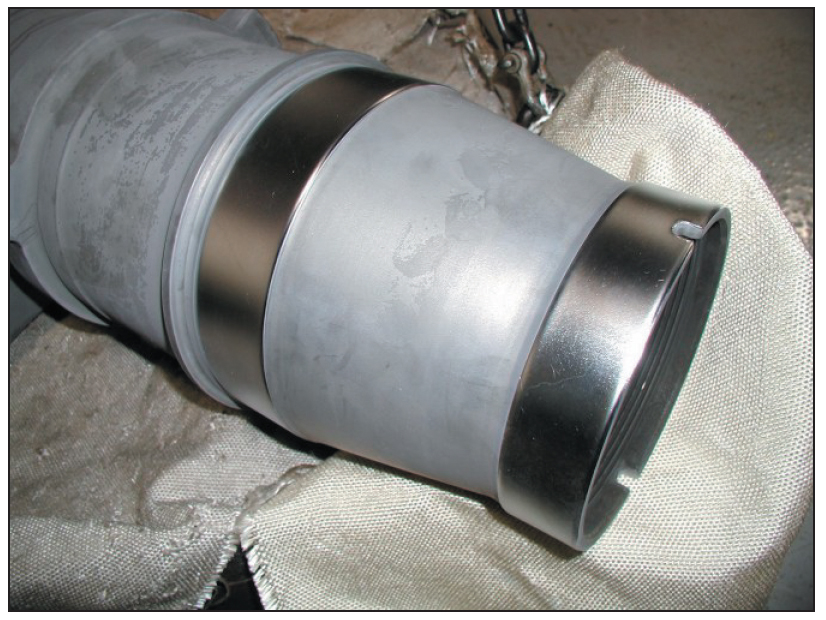Hard Chrome Plating Training Course
Section 1—Course Overview

Exhibit 1-1. C-5 landing gear forward axle plated using a conforming no-mask anode.
Purpose
If you are just starting out in hard chrome plating, or if you are an experienced chrome plater but would like a better understanding of the principles behind the process, this course is for you.
This course covers chrome plating in a different way. Good information sources are available for engineers and for chemists. But there are few references that have been written particularly for the people who have to load the racks and set the controls, or for those responsible for making sure the job is being done right.
Another feature of this course is generally not mentioned in more technical references. It is important that anyone who plates chrome have a healthy respect for it, both for its remarkable capabilities, and for the effects that it can have on people and the environment. It is important that chrome platers understand both what chrome can do for them, and what it can do to them. This course will help you appreciate the power of chrome, and help you work with it effectively and safely.
Hard chrome plating is one of the trickiest metal finishing processes to master. There are many possible pitfalls. But if you learn the fundamentals, and learn how to apply them to your work, you will be well on your way to being a skilled hard chrome plater and producing quality parts.
Scope
The hard chrome plating course is divided into eight sections:
Section 1. Course Overview
Section 2. Introduction to Hard Chrome Plating
Nickel, copper, silver, zinc, or other electroplated metals all play an important role in manufacturing. However, there is something special about hard chrome that makes it a first-class process. Maybe it's the hardness or durability of hard chrome, or perhaps the wide range of important functions it plays in aircraft, engines and machinery. This section provides an introduction to a world of possibilities.
Section 3. Process Chemistry and Equipment
You don't need to be a chemist or an electrical engineer to plate hard chrome, but having a basic understanding of process chemistry and electroplating equipment will help you be a better plater. This section provides some fundamentals that will help you through the rest of the course.
Section 4. Plating Procedures
This section of the course covers the range of hard chrome procedures you will need to successfully plate most of the parts you encounter. It starts with a discussion of preplating procedures, such as cleaning and masking. We then cover plating, and finally conclude with post-plating procedures, such as hydrogen embrittlement relief.
Section 5 Troubleshooting
If you follow good plating procedures, your parts will usually have a uniform bright chromium deposit. However, sooner or later, you are going to generate a mis-plated part. This section gives you tools to help figure out what went wrong and how to correct it.
Section 6. Plating Bath Fitness
Hard chrome baths are durable, but they can go out of whack if you don't follow preventative measures and correct problems before they get out of hand. This section will help you keep your bath in top shape, resulting in faster plating rates and brighter deposits.
Section 7. Health and Safety
There are significant health and safety risks associated with hard chrome plating. Rules exist that must be followed to meet federal and state regulations. However, beyond just meeting these standards, you need to be aware of the potential dangers and take the proper precautions. This section will help you be a safe and healthy hard chrome plater.
Section 8. Pollution Prevention
Plating shop wastes are costly to manage, cleanup and dispose of, and they can have a severe impact on our environment. This section emphasizes pollution prevention, which means reducing the quantity of waste generated. It is much more efficient to avoid generating waste than to deal with it later.
Appendices
At the end of this book there are a set of appendices that contain important information and data that will make your job a bit easier. You will make use of these during the course and you will want to keep them for future reference.
After each section, you will find a quiz. These quizzes will help you evaluate how well you learned the material presented in the course. Answers to the quizzes are in Appendix 1.
Additional Resources
This course contains a practical approach to hard chrome plating. People who want to learn more detailed engineering aspects of the process should consult text books and consider taking a course from the American Electroplaters and Surface Finishers (AESF) Society Foundation. AESF courses cover various topics, including hard chrome plating and they can be taken at various regional locations throughout the year. Home study courses are also available. AESF courses can lead to various levels of certification. For more information on AESF Foundation courses, visit www.nasf.org.
The National Metal Finishing Resource Center (NMFRC), located on the Internet at www.nmfrc.org, has a wealth of information on hard chrome plating and other metal finishing processes. Since 2002, the NMFRC has operated a hard chrome "Ask the Expert" feature that allows you to interface with National experts. This feature includes a searchable Q&A archive that covers many basic and advanced topics.

